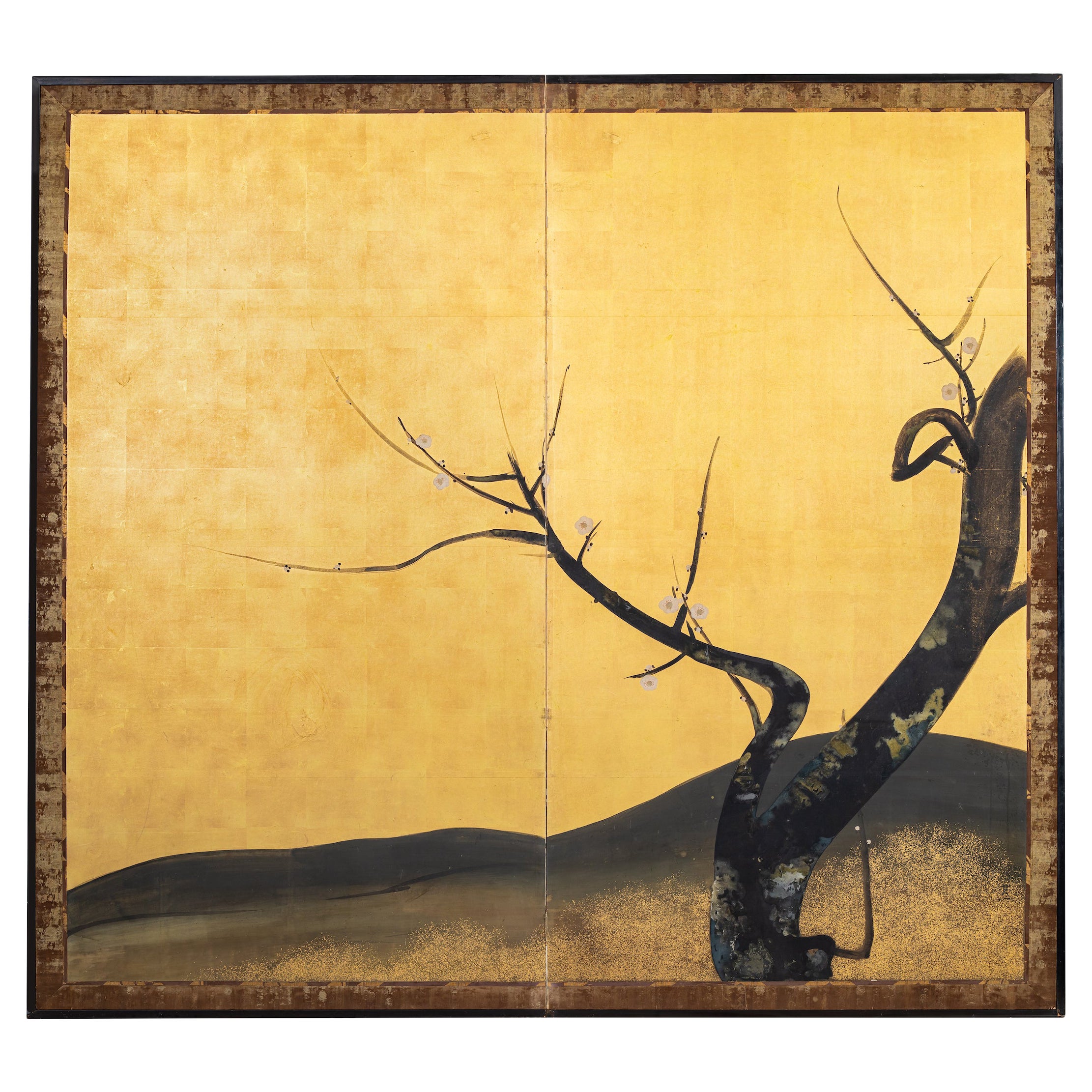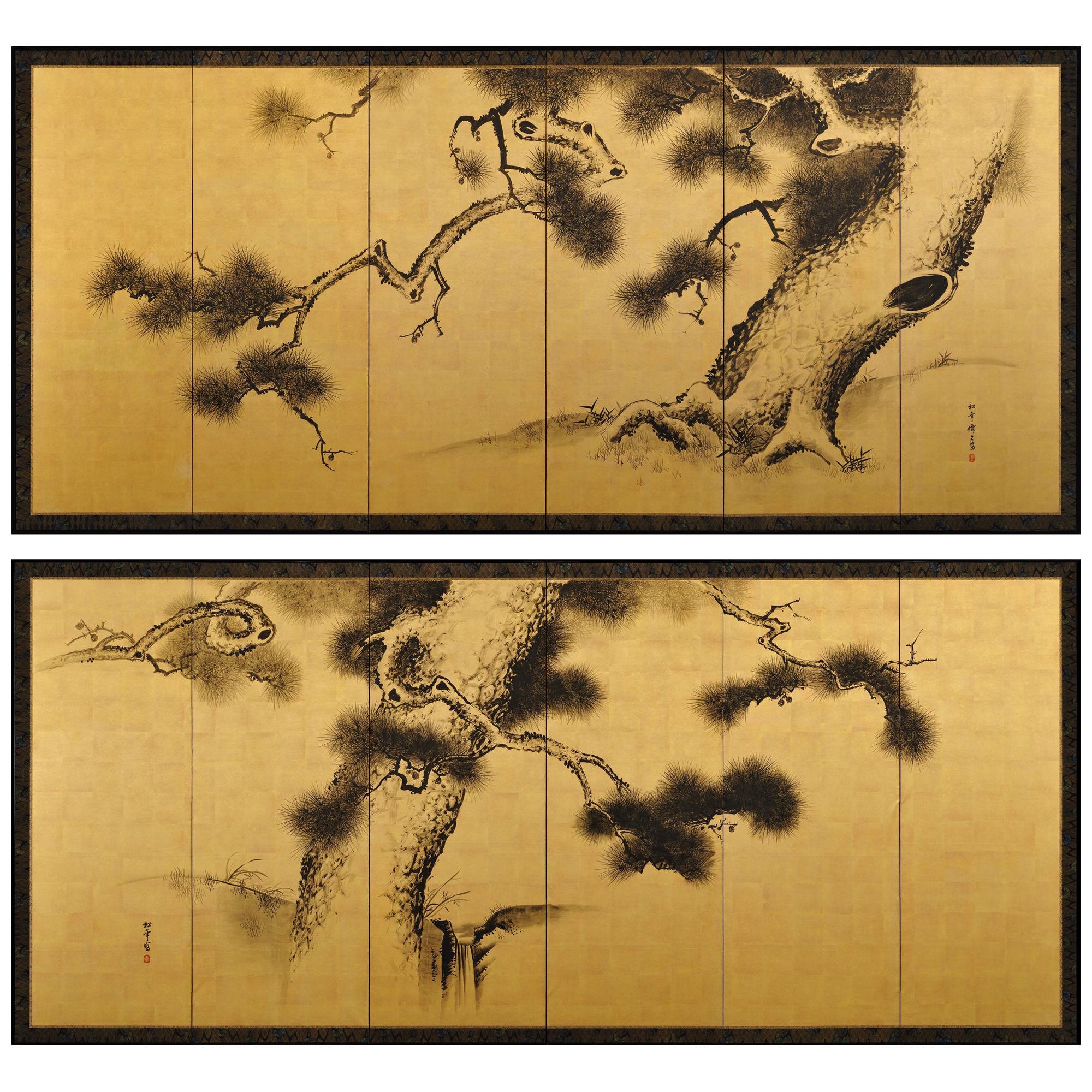Items Similar to 19th Century Japanese Screen for Tea-Ceremony, Ink Bamboo and Plum on Gold Leaf
Want more images or videos?
Request additional images or videos from the seller
1 of 10
19th Century Japanese Screen for Tea-Ceremony, Ink Bamboo and Plum on Gold Leaf
About the Item
Three Friends of Winter
Nakajima Raisho (1796-1871)
Late Edo period, circa 1850
Ink and gold leaf on paper.
This is a double-sided Japanese Furosaki or tea-ceremony screen from the mid 19th century; bamboo and plum on the front, young pines the back. It by Nakajima Raisho, a master painter of the Maruyama school in the late Edo and early Meiji periods. In this work Raisho combines exquisite ink brushwork with large open spaces of brilliant gold-leaf to inspire the viewers imagination. Rather than naturalism, he is searching for the phycological impression of the motifs, resulting in abstraction and stylization. His simplification of the motifs the result of looking to capture the inner nature of the objects. This art motif is known as Sho Chiku Bai, or the Three Friends of Winter. Evergreen pine connotes steadfastness, bamboo suggests both strength and flexibility, while plum blossoms unfurling on snow-laden branches imply hardiness. Combined, this trio is emblematic of Japanese new year. Chinese literati were the first to group the three plants together due to their noble characteristics. Like these resilient plants flowering so beautifully in winter, it was expected of the scholar-gentleman to cultivate a strong character with which he would be able to show the same degree of perseverance and steadfastness even during times of adverse conditions.
The screen would have been placed near the hearth of a room used for the Japanese tea ceremony, shielding the fire from draughts and also forming a stimulating and decorative backdrop behind the tea utensils. It would have been used in the Hatsugama, or first tea-ceremony of the new year.
Nakajima Raisho (1796-1871) originally studied under Watanabe Nangaku before entering the school of Maruyama Ozui. He was the highest ranking Maruyama school painter at the end of the Edo period and was known as one of the ‘Four Heian Families’ along with Kishi Renzan of the Kishi school and Shiokawa Bunrin and Yokoyama Seiki of the Shijo school. Among his disciples were Kono Bairei and Kawabata Gyokusho, who also became important figures in the Kyoto art world.
- Dimensions:Height: 29 in (73.66 cm)Width: 74 in (187.96 cm)Depth: 0.75 in (1.91 cm)
- Style:Edo (Of the Period)
- Materials and Techniques:
- Place of Origin:
- Period:
- Date of Manufacture:circa 1850
- Condition:Wear consistent with age and use.
- Seller Location:Kyoto, JP
- Reference Number:1stDibs: LU2472331424482
About the Seller
5.0
Recognized Seller
These prestigious sellers are industry leaders and represent the highest echelon for item quality and design.
Gold Seller
These expertly vetted sellers are highly rated and consistently exceed customer expectations.
Established in 2001
1stDibs seller since 2016
62 sales on 1stDibs
Typical response time: 6 hours
- ShippingRetrieving quote...Ships From: Kyoto, Japan
- Return PolicyA return for this item may be initiated within 10 days of delivery.
More From This SellerView All
- Japanese Screen, 19th Century, Rabbits and Horsetail Reeds on Silver LeafBy NenmaLocated in Kyoto, JPUnknown artist Rabbits and Horsetail Reeds Painted in the Year of the Fire Dog, 1826 or 1886. 19th century. The scene depicted here is set under moonlight, with two hares hidden amongst Japanese horsetail reeds. In Japan horsetails have long been associated with the rabbit or hare, which is said to use this silica-rich plant to polish the disc of the moon. It is a furosaki screen, made for use during the tea-ceremony, and it would have been used in ceremonies to celebrate the Mid-Autumn-Moon. In Japan the full moon and the hare have become associated with autumn as this is when the moon is deemed to shine brightest. Hares or rabbits and the moon are often linked together in East Asian folklore. Japanese legends describe the shadows on the surface of the moon as hares pounding sticky rice cakes while an ancient Chinese-Taoist tale tells of a hare that resides in the moon and pounds magic herbs in order to make an elixir of longevity. With this bold compositional design and the distillation of patterns and motifs, the artist has clearly been inspired by paintings of the Japanese Rimpa school. In particular, the work seeks to emulate the innovative artistic styles of the 17th century Rimpa pioneers, rather than the delicate depictions of the later Edo-Rinpa school. The forms of the rabbits can be traced back to the sliding doors of Yogen-in temple painted by Tawaraya Sotatsu, and further to fan paintings by Honami Koetsu...Category
Antique Mid-19th Century Japanese Edo Paintings and Screens
MaterialsSilver Leaf
- 17th Century Japanese Screen. Ink Plum Tree & Birds by Kano Naonobu.Located in Kyoto, JPKano Naonobu (1607-1650) Plum Tree and Birds Six-fold Japanese Screen. Ink and slight color on paper. In this evocative ink work spread over a six-panel folding screen, we see the consummation of the elegance and refinement of the Edo Kano school. This 17th century screen is a rare surviving example of a large-scale bird and flower painting by Kano Naonobu, the younger brother of Kano Tanyu...Category
Antique 17th Century Japanese Edo Paintings and Screens
MaterialsWood, Paper
- Japanese Screen pair. Late 19th Century. Ink Pine Trees on Gold by Suzuki ShonenLocated in Kyoto, JPSuzuki Shonen (1848-1918) Meiji period (1868-1912), late 19th century. Twisted pines Pair of six-fold screens. Ink on a gold leaf ground. Sig...Category
Antique Late 19th Century Japanese Meiji Paintings and Screens
MaterialsGold Leaf
- 17th Century Japanese Screen Pair by Soga Nichokuan, Hawks on Pine & Plum TreesLocated in Kyoto, JPHawks on plum and pine Soga Nichokuan (active circa 1625-1660) Pair of six-fold screens. Ink, mineral pigments, gofun, gold and speckled gold leaf on paper. Upper seal: H...Category
Antique 1640s Japanese Edo Paintings and Screens
MaterialsWood, Paper
- Japanese Painting, Hanging Scroll, 19th Century Bamboo in MoonlightLocated in Kyoto, JPBamboo in moonlight Gamo Rakan (1784-1866) Hanging scroll, ink on silk. Dimensions: Scroll: 201 cm x 58 cm Image: 137 cm x 45 cm In this early 19th century work by Gamo Rakan a light ink wash applied to the silk background silhouettes the moon and suggests the atmosphere of early evening. Even though it is a literati subject, Rakan’s bamboo is quite realistic with a strong decorative style. The painting finds its inspiration from Chinese Ming dynasty painters who often used a single-tone, jet black stroke to emphasize the calligraphic nature of bamboo. In a different era, decorative would have been seen as somewhat unrefined. But increasingly in the Edo period, it was the hallmark of high style. The Japanese people, in particular the rising merchant class, had gradually become apathetic toward the traditional Sesshu and Kano schools of painting. Chinese professional and amateur painters living in the port of Nagasaki during the 18th century had a profound effect on Japanese painting and the freshness of their style and its decorative appeal contributed greatly to its popularity. Gamo Rakan’s teacher, Tani Buncho...Category
Antique Early 19th Century Japanese Edo Paintings and Screens
MaterialsSilk
- Early 20th Century Japanese Screen Pair - Ink Pine Trees on GoldLocated in Kyoto, JPImao Keisho (1902-1993) Pine Trees Early 20th Century, Circa 1930 Pair of six-panel Japanese screens. Ink on silk and gold leaf. Dimensions: Each screen H. 67.5” x 148” (172 cm x 376 cm) A pair of monumental six-panel Japanese pine screens by the renowned Nihonga artist Imao Keisho. Here Keisho entirely removed the background and brought the pine trees to the surface of the painting. This simplification of the elements makes the scene exceptionally direct and compelling and injects a very modern...Category
Early 20th Century Japanese Showa Paintings and Screens
MaterialsGold Leaf
You May Also Like
- Japanese Two Panel Screen Winter Flowering Plum on Gold LeafLocated in Hudson, NYMineral pigment on gold leaf.Category
Antique 19th Century Japanese Paintings and Screens
MaterialsGold Leaf
- Six-Panel Japanese Screen on Spring Gold LeafLocated in Brescia, ITSpring landscape by an unknown painter of the Rinpa school, 19th century, six-panel ink painted on gold leaf on rice paper. The flowers are made with the "gofun" technique, natural or pigmented white oyster powder. Rinpa (? ?, Rinpa) is one of the major historical schools of Japanese painting. the style was consolidated by the brothers Ogata Korin (1658–1716) and Ogata Kenzan...Category
Antique Late 19th Century Japanese Edo Paintings and Screens
MaterialsGold Leaf
- Japanese Folding Screen Six Panels Painted on Gold LeafBy Japanese StudioLocated in Brescia, ITParavento a sei pannelli di scuola giapponese Kano: paesaggio con bellissime ed eleganti gru vicino al fiume, con alberi di pino e sakura. Dipinto a mano con pigmenti minerali ed inc...Category
Antique Early 19th Century Japanese Edo Paintings and Screens
MaterialsGold Leaf
- Japanese 2-Panel Furosaki’byôbu 風炉先屏風 'Tea-Ceremony Folding Screen' with DragonsLocated in Amsterdam, NLA striking low and wide two-panel furosaki’byôbu (tea-ceremony room divider) painted with two bright white dragons (ryû) flying amidst swirling black clouds. The left dragon holds a ...Category
Early 20th Century Japanese Paintings and Screens
MaterialsWood, Paper
- Japanese Antique Ink Painting / 19th Century / Rare Chinese Character PaintingLocated in Sammu-shi, ChibaWe have a unique Japanese aesthetic sense. And only we can introduce unique items through our purchasing channels in Japan and the experience we have gained so far, in such a way that no one else can imitate. It is an ink painting written after the Meiji era. The biggest attraction of this work is that it uses Chinese characters to create paintings. To explain in detail, it is written here in Chinese characters as "un-ryu" . "Un" is a cloud and "ryu" is a dragon. These are embodied and drawn by comparing them to the meaning of Chinese characters. And the clouds depict the clouds hanging over the mountain, and the dragon depicts the climbing toward the mountain. Humorous paintings...Category
Antique Late 19th Century Japanese Edo Paintings
MaterialsAcrylic, Paper
- 19th Century Japanese Edo Six Panel Kano School Landscape ScreenLocated in Rio Vista, CALate Edo period 19th century Japanese six-panel landscape screen featuring a cypress tree over a flowering hibiscus with a pair of hototogisu birds. Kano school painted with ink and ...Category
Antique 19th Century Japanese Edo Paintings and Screens
MaterialsSilk, Wood, Paper
Recently Viewed
View AllMore Ways To Browse
Mid Century Screen
Wood Screen Mid Century
19th Century Bamboo
Antique Japanese Screens
Japan Antique Screens
Antique Plum
Midcentury Japanese Screen
19th Century Wood Screens
Gold Leaf Screen
Asian Gold Leaf Art
Antique Japanese Bamboo
Decorative Mid Century Screen
Large Asian Screen
19th Japanese Screens
Chinese Gold Leaf
Japanese Screen Ink
Chinese Screen Circa
Japanese Screens Large





